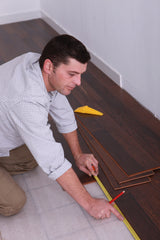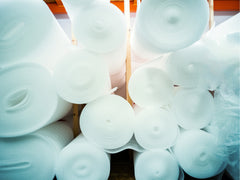My shopping cart
Your cart is currently empty.
Continue ShoppingOne of the most important yet overlooked products of floating floors is the underlayment. This product is the hidden gem beneath your floor that can separate a good floor from a great floor. The underlayment itself provides a smoother surface for your floor than the subfloor alone, and gives the entire floor better stability.
By definition underlayment is - a layer of material between a subfloor and a finished floor that smoothes minor imperfections in the subflooring surface. In fact many underlayments can offer sound control, moisture control, anti-bacterial, and anti-fungal properties.
There are 2 required elements that are necessary for your floor to last a long and healthy life; moisture protection and padding (smoothing minor imperfections in subfloor). While not essential in the longevity of the flooring itself, the added benefit of sound control may be a priority for some. Make sure to follow the floor manufacturer’s installation and warranties before deciding on an underlayment.

This is an important aspect of underlayment as it can prevent costly repairs and replacement of your floor. More importantly it will also protect the health of you and your loved ones from fungi and bacteria that thrive in moist environments. Note that when an underlayment is referred to as 3-in-1, it has the properties of cushioning, sound deadening and moisture protection. Underlayments that have little or no moisture barrier properties must be used in combination with PE (polyethylene) plastic sheeting specified for flooring.
Sound dampening properties are also important and good underlayments can significantly reduce noise inside and below the room. Acoustic properties can be divided into two categories:
STC – In the room sound:
Noise generated in the room and heard by those below the room. This includes airborne sound from TVs, stereos and even conversations and are measured in a test referred to as the Sound Transmission Class (STC)
IIC – Below the room sound:
Noise generated in the room by walking on and moving things across the floor and heard by those in the room below are measured in a test referred to as the Impact Insulation Class (STC).
Within the room sound:
An important factor – but not measured scientifically – is the quality of sound in the room that is related to the underlayment. Depending on the type of flooring, underlayment and subfloor, this is often described as “hollow”, or “solid”. Drop a golf ball on the floor to get a sense of this.
To better understand this, an example is a typical interior wall in your home (1/2″ drywall on either side of a wood stud) that has an STC of about 33. People often describe these walls as "paper thin" as sound travels easily through them.
For STCs and IICs, building codes require a floor rating of 50 (laboratory tested) or better. The higher the number the better sound dampening qualities an underlayment has. Most quality underlayments have been tested and will have this information readily available on packaging or upon request.
Please note that laboratory tests and the specs of your house and building material may result in different ratings.
Knowing what types of underlayment are out there can also help in your buying decision. There are four different types to choose from: fiber, foam, cork and rubber.
This has some of the best ratings for sound dampening. This will help with the everyday foot traffic and extra noises produced by TV’s and stereos. This, along with moisture control is what you truly want in your bedrooms or living rooms. Some of these fiber underlayments will also insulate cold floors.
(Including SuperFoam’s EPS beads) is great for potentially moist areas of the house. Although they do have sound dampening capabilities, they are meant for bathrooms, or basements where you might have slightly higher moisture exposure. This underlayment also has a lower cost than fiber underlayment. Some higher quality PE foam underlayments are “cross-linked”. These appear rubbery, soft and are more expensive, but have better ratings all around. SuperFoam is constructed of tough EPS beads that wick moisture to the perimeter.


GoldStep
Sound-Dampening & Moisture Barrier in ONE

SilverStep
Quick Installation, Sound & Moisture Control

BronzeStep
Economical & Covers Basic Needs
